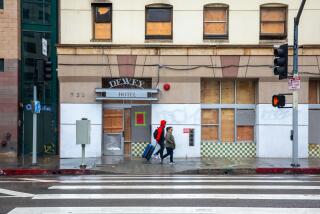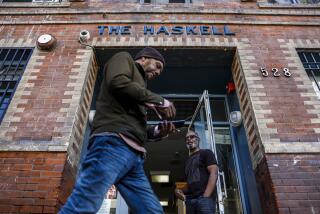Column: The Rev. Andy Bales on skid row and the myths about homelessness
The Rev. Andy Bales doesn’t need to read the studies to know what’s what on L.A.’s skid row. It’s flat-out bad — the worst he’s seen in nearly 20 years as the CEO of the Union Rescue Mission, which was founded in 1891 and is skid row’s oldest shelter. More than a third of the nation’s chronically homeless live in California, and Los Angeles County now has the nation’s largest homeless population: 44,000. If the homeless were their own city, it would rank in size somewhere between Bell Gardens and Azusa. The week before Thanksgiving — a big event on skid row — the L.A. City Council voted to make some public buildings and parking lots available to the homeless this winter. It did not, though, declare an official homelessness emergency. Bales — who gets around in a wheelchair because a staph infection contracted on the streets ravaged the bones in a foot and ankle — doesn’t understand how it can be anything but.
[In New York] they spend a billion a year on homelessness issues. L.A. needs a basic heart change.
The numbers of homeless in L.A. have risen at least 12% in two years. Why do you think that has happened?
It’s upheaval in our community, [in] systems like mental health and prison and foster care. I think they’re broken. I think it’s the pace of life in L.A.; people are medicating themselves with alcohol or drugs. I have seen [professional-looking women] and they say “Hi, Andy,” and I figured they were touring. [Then] I realized they’re our guests; this is what they can afford, the working poor who get off their jobs and come here: three meals a day, their own bunk and footlocker. Even during the Great Recession, we didn’t have the numbers of people on the street.
Both the city and the county are talking about spending big on homelessness — $100 million each.
Those aren’t big numbers. [The county wants to] do affordable housing [over many years], about 300 units because they’re very expensive to build. With
$100 million, Union Rescue Mission could leverage the empty Martin Luther King Jr. hospital; the empty youth authority camp in Whittier; McLaren Hall [in] Downey — the poor farm, it was called during the Depression — and we could get 3,900 people off the street tonight and provide [them with] 24/7 comprehensive medical, dental, mental, legal care for 365 days a year.
Many politicians now seem to endorse “permanent supportive housing” — apartments plus services for the homeless — and that can be a problem for shelters like yours. But isn’t permanent supportive housing a good idea?
It’s one of many good ideas. It’s not the idea, the silver bullet to end homelessness. They’ve done such a good marketing job — [saying] permanent supportive housing is the solution and the missions and shelters are archaic — that resources just shifted. We have had to fight like crazy to even survive.
You need multipronged strategies. You shouldn’t demonize shelters because you need shelters to put a roof over people’s heads while they wait for the housing to be built.
By focusing on the few, you are very likely to leave many people out on the streets. This just puts even bigger gaping holes in an already weak safety net. Over 70% of people experiencing homelessness don’t have a roof over their heads at night here, and New York is embarrassed because they have about 4%. They spend a billion a year on homelessness issues. L.A. needs a basic heart change.
Does permanent supportive housing work for everyone?
Not everybody can take care of their own place. You have people who have had permanent supportive housing and end up back on the streets and come back to the mission for either recovery or shelter. Our job here is a life transformed, followed by a job, followed by a home.
Have you lost specific funders to permanent supportive housing?
Yes. One foundation that gave us a grant as high as $750,000 said, “We are no longer going to fund shelters at all.” One pastor said 28 churches were considering moving completely away from shelters to permanent supportive housing. We lost most but not all of their support. There are several agencies facing the loss of millions of dollars because of the shift.
Maybe politicians are reluctant to acknowledge there’s a problem that won’t be solved by cutting a ribbon on a new building and saying, “We’ve taken care of that.”
There’s a denial of just how bad things have gotten. [Politicians] need to be in a cold parking lot at night holding a 2-month-old; to come alongside a guy dying on skid row, he’s 6 foot 3 and 90 pounds and too weak even to pull up his own pants. They need to see that firsthand to drive home that we need to pull out the stops. We need leadership that [won’t] back down every time some neighborhood group says “Not in my backyard.” We are our brother’s keeper. Those people experiencing homelessness — that could be me, right? One bad episode and that could be me. We’ve got to have that mind-set in L.A.
I always try to say “people experiencing homelessness,” not “the homeless,” because that writes them off, as if they were less than a person. They were once someone’s precious baby [whose parent] once held them and said, “The world revolves around this baby.”
As El Niño approaches, some people living outdoors aren’t taking the danger seriously.
I know stubborn people. If you approach them enough with the right offer, when the weather’s rough enough, they will come in if there’s a place to go. Right now there’s no place to go. The missions are full. It doesn’t do any good to criminalize people or fine them for putting up tents, but if they do have places to go and you are persistent, many will make the right decision.
How do you feel seeing the city put so much effort into housing homeless veterans?
I don’t mind the concentration and focus on veterans because they’ve served our country; what I don’t like is that for a while our mayor and others were saying they were going to focus first on veterans and then we’ll get to everybody else. I think you can focus on veterans and kids and women and skid row.
What are the myths about homelessness?
One is that people come to L.A. to experience homelessness in the great weather, and that’s not the truth. Seventy percent of the people in the [homeless] count have been here 10 years or more. Many came here with a dream. That dream didn’t work out and they ended up on the streets. The vast majority of the people on skid row are from L.A.
The other myth is that [the biblical] quote — “The poor, you’ll always have with you” — [is] a case for inaction. But in one of the books of the Bible, Jesus says, “The poor you’ll always have with you to be kind to every day.” He’s quoting Deuteronomy. So what’s being used as a call to inaction [actually says] we’ve got to look after our neighbors, our brothers and sisters. I say skid row is the biggest man-made human disaster in the U.S. We made this corral-and-containment system. There’s a wiser, better approach.
You’ve already served some big Thanksgiving meals ahead of the holiday rush. Does it annoy you a bit that so much attention is focused on one single day of the year on skid row?
Every day is a big day; every day we have 2,000 meals and hundreds of volunteers. Our big event is the Saturday before Thanksgiving — 4,500 or 5,000 people who come for Thanksgiving dinner. And caring [volunteers] overwhelm us. It should happen every day. And it does here.
This interview has been edited and condensed.
Twitter: @pattmlatimes
Follow the Opinion section on Twitter @latimesopinion and Facebook
More to Read
A cure for the common opinion
Get thought-provoking perspectives with our weekly newsletter.
You may occasionally receive promotional content from the Los Angeles Times.







